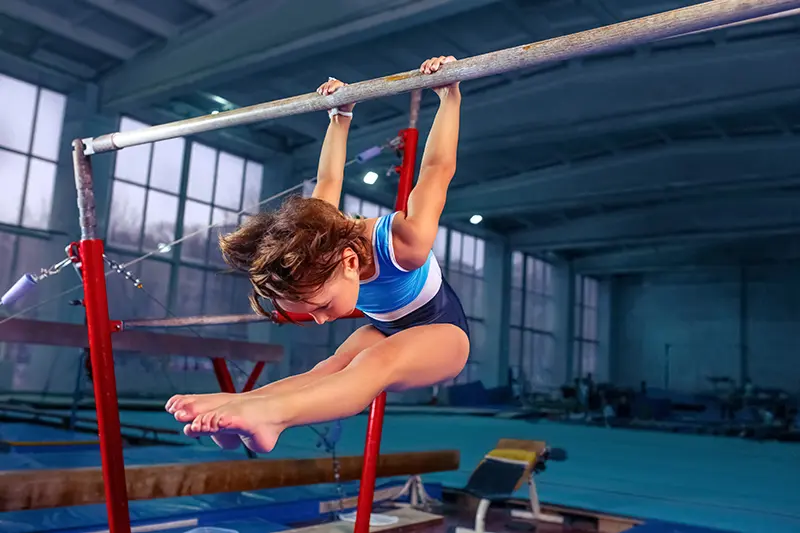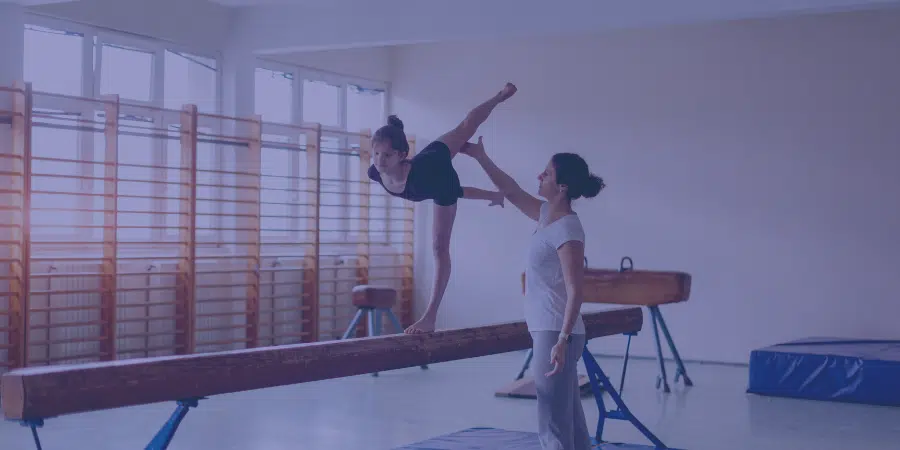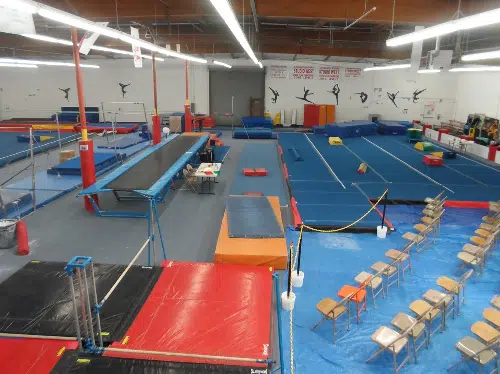Opening your own gymnastics gym is a great adventure and a wonderful way to serve athletes and their families in your community. Here is a quick guide to the gymnastics equipment you’ll need to get started, including how to clean and care for your equipment.
Your Gymnastics Equipment List
Your gymnastics equipment list will vary, however, these are some of the most common types of gymnastics equipment you’ll need to outfit your gym:
- Flooring
- Mats
- Safety equipment
- Rhythmic gymnastics equipment
- Balance beam
- Pommel horse
- Still rings
- Vault
- Bars
You’ll tailor your gymnastics gym equipment to the ages, needs, and skill level of your gymnasts, as we’ll discuss. If you are teaching gymnastics to kids, then a preschool gymnastics gym will not look the same as an Olympic-focused training facility. Once you decide where your focus lies, you can outfit your gym accordingly.
Let’s look at all of these types of equipment in more detail.

Flooring
The floor of your gymnastics space might be the most important decision you make when it comes to outfitting your gym. Common flooring materials include:
- Rubber
- Foam
- Cork
Some gyms use carpet or vinyl. These options are more affordable but less durable.
Mats
Regardless of the level of your students, gymnastic safety mats are crucial to have in your gym. You need a wide variety of gymnastic mats that may include the following:
- Dismount mats
- Springboard mats
- Landing mats
- Throw mats
- Cartwheel beam mat
- Incline mats
- Tumbling mats
- Panel mats
Which ones you need will depend on the types of classes you offer, the age of your students, and more.
Safety equipment
Safety equipment includes the mats listed above, but also includes foam pits for practicing dismounts and trampolines to work out new tricks.
Gymnasts will bring their own personal safety equipment (e.g., wrist braces and specialized footwear), but spotting belts are a good idea to have on hand. You may also plan to sell or rent out personal safety equipment from your gym.

Rhythmic gymnastics equipment
Students compete in rhythmic gymnastics with specialized gymnastics equipment. You may bring in tools like:
- Balls
- Hoops
- Ropes
- Clubs
- Ribbons
Balance beam
This four-inch wide apparatus is an iconic piece of gymnastics equipment.
Note that the regulation height is just over four feet, but you may want different heights for different levels of experience. Especially if you have younger students, you may start with a lowered beam for practicing.
Pommel horse
This piece of equipment is made of a metal body encased in foam and rubber, with handles (pommels). Traditionally, it’s been used by male gymnasts.
A pommel (or side) horse is an investment for future Olympians and amateur competitors alike as it allows your students to perform major stunts and competitive moves.
Still rings
The still rings are another piece of equipment standard in men’s gymnastics. These are usually mounted on bars just under 19 feet off the floor (the rings are just over eight feet off the floor).
This apparatus requires a good bit of space, so if your gym is small or new it may not be a priority at first.
Vault
Both male and female gymnasts use a vault, which requires not only the apparatus but also a springboard, landing mat, and plenty of space for running and landing.
Although each vault is only three feet wide and just under four feet long, you will need two heights, one for men (just under four and a half feet) and one for women (just over four feet).
Bars
When it comes to gymnastics equipment, bars are one of the most important items on your gymnastics equipment list. Bar routines utilize three different apparatus. Each of these requires a good bit of space, both for safety and due to their size. They include:
- Parallel bars: Parallel bars are used in men’s gymnastics and are 11 feet long
- Uneven bars: The higher bar measures just over eight feet and the lower just under six; gymnasts often use the lower bar to work on new skills as well
- Horizontal (high) bars: This steel bar, held high off the ground (approximately nine feet) by a series of poles and cables, is used in men’s gymnastics events
Where To Find Gymnastics Equipment
Your search for affordable gymnastics equipment that is also safe and meets regulations can start at a local big box sporting goods retailer and go from there. There are a number of high-quality brands that design gymnastics equipment, so shop around to find the features and price points you’re looking for.
Buying new equipment means it is covered by the original manufacturer’s warranty, but if you are working with a budget, you still have options. Other places to find affordable, yet safe, gymnastics equipment include:
- Buy from closing gyms: Everything from flooring to apparatus is usually offered at a deep discount when a gym closes its doors.
- Shop demo equipment: Some gymnastics equipment retailers will offer demo equipment at a reduced price with a limited manufacturer’s warranty attached.
- Look for reputable gymnastics resellers: Reputable resellers will stand behind their used equipment and verify its safety. These resellers may also offer trade-ins for your used equipment when you are ready to upgrade.

Caring For Your Gymnastics Equipment
Once you have your equipment, it pays to keep it maintained to increase its longevity. The manufacturer will offer specific guidelines for care and sanitation of each piece of equipment, but generally speaking, here are some rules to keep your gymnastics equipment (and your facility) safe and clean.
Inspect all equipment before each use
Whether you buy shiny new products or more affordable and well-used tools, safety should be your number one concern. All padding should be intact with no rips, tears, or thin spots. Bolts, screws, and cables should be secure and show no signs of wear. Mats and flooring should have give and bounce.
Make sure to inspect all equipment before each use, regardless of age.
Clean mats regularly
Mats of all kinds should be cleaned and sanitized on a regular basis. Look for cleaners that meet EPA standards for safety and CDC standards for sanitation.
Vacuum and mop daily and deep clean once a week (or more, depending on how you use your gym).
Wipe down apparatus
Use cleaning wipes or disinfectant spray to sanitize handles, bars, and other non-porous surfaces regularly.
Keep a clean space
Clean the entire gym thoroughly each day. This includes common areas and bathrooms as well as equipment and exercise areas. Doing so keeps your athletes and their waiting families safe and healthy.
Important Things to Remember about Buying Gymnastics Equipment
Build Your Studio
Now that you have the gymnastics equipment you need, it’s time to hit the ground running. You help your gymnasts achieve their goals, and Studio Director will help take care of the rest. Our comprehensive studio management system automates key tasks, like attendance tracking and payments, so you can focus on growing your gym.
Want to see what Studio Director can do before you dive in? Start with a free trial to explore our digital solutions that make running your gymnastics gym a breeze.



